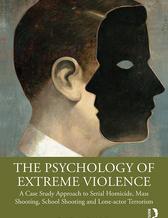
- Home
- News and events
- Find news
- New book published by Clare Allely "The Psychology of Extreme Violence"
New book published by Clare Allely "The Psychology of Extreme Violence"
Clare Allely's newly published book features a unique overview of the different forms of extreme violence.
On May 23, 2014, a 22-year-old man embarked on a ‘premeditated, murderous rampage’ in Isla Vista Santa Barbara, California killing six people, himself, and injuring 14 others. On December 14, 2012, a 20-year-old man shot his mother multiple times in the head before going out and killing 26 people, 20 of them young children, inside Sandy Hook Elementary School in Newtown, Connecticut. On 22 July 2011, a Norwegian man killed 77 people during two well-planned attacks. The first involving the bombing of government buildings in Oslo and the second being the shooting spree on the island of Utøya. In the aftermath or detection of such terrible tragedies and extreme acts of violence the same questions are always asked. What motivated the individual to perpetrate such acts of extreme violence? Were they mentally ill? Were they insane? Did they have any brain abnormalities? Did they come from an abusive background? Were there any red flags or warning signs of what was to come? Could it have been prevented? What can we do to avoid more of these tragedies in the future?

In this book, Clare Allely has attempted to explain the motivations and circumstances that inspire acts of extreme violence including: serial homicide, mass shootings, school shootings and lone-actor terrorism. A number of cases of extreme violence are explored and the pathway to violence in each case is studied. Detailed case studies include: Jeffrey Dahmer; Dennis Rader; Theodore Kaczynski; Adam Lanza; Dylann Roof; Elliot Rodger and Anders Breivik. All these acts of extreme violence were the outcome of a constellation of contributing causes, none of which themselves is sufficient to explain a school shooting. There is no single causal factor which propelled each of these individuals to carry out their extreme act of violence. For instance, in the case of the Sandy Hook Elementary School shooter, Adam Lanza, there were multiple pathways which culminated in the eventual attack including: loss of school; absence of work; disruption of the relationship with his one friend; virtually no personal contact with family; virtually total and increasing social isolation; fear of losing his home and of a change in his relationship with his mother who was his only caretaker and connection; worsening psychiatric mental health (obsessive compulsive disorder, depression and anxiety); profound and potentially worsening anorexia and an increasing preoccupation with mass murder occurring in the absence of any interaction with the outside world (Office of the Child Advocate, 2014). Specifically, in November 2012, it was reported that Lanza’s mother was concerned about him because he had not left the house in three months and was only communicating with her using email despite the fact that they were both living together in the same house (Sedensky, 2013). Lanza had become increasingly disconnected from reality and was living in isolation in an alternate universe in which his ruminations about mass shooters were his central preoccupation (Office of the Child Advocate, 2014). A summary of the official investigation into the tragedy in Newtown provided details regarding Lanza's behaviour in the lead up to his attack (Sedensky, 2013). The report also detailed one of the findings from the investigation, namely, a seven-by-four-foot sized spreadsheet with detail on about 500 mass murderers which underscored the degree of Lanza’s fascination with other mass shooters. The spreadsheet contained extensive detail on each attack including data on the victim counts and weapons used by the mass shooter. The level of detail of this spreadsheet lead investigators to believe that it had involved years of work to create and was even used as a “score sheet” (in terms of body counts of the mass shootings, etc.) by Lanza (Gendreau, 2013).
What the research and the case studies in this book highlight is that although there appears to be no consistent perpetrator profile, the awareness and identification of the red flags/warning signs in combination with leakage, offers a promising approach. Criminologist Dr Adam Lankford from the University of Alabama (2018) has developed checklists of warning signs that can be used by law enforcement to help them determine whether an at-risk individual appears to have: (a) suicidal motives or life indifference that might eliminate fear of consequences, (b) perceptions of his or her own victimisation that might rationalise attacks against targets, and (c) desires to obtain fame or attention through killing. Lankford and colleagues (2019) studied the 15 deadliest public mass shootings which occurred in the United States between March 1998 and February 2018 and found that most appear to have been preventable (based on information which was known about perpetrator prior to their attack) (Lankford, Adkins, & Madfis, 2019). Lankford indicates that “fame -- or infamy -- has emerged as a common thread in mass shootings.
It has also been highlighted by Dr Peter Langman (2017) that there are numerous mass shooters who have experienced biological challenges to their identities. Also, because the majority of mass shooters are male, these biological issues may have presented as a challenge to their sense of masculinity. Biological issues include medical problems (e.g., birth defects or significant illnesses), appearance-related factors (e.g., shortness, obesity, severe acne) and also functional matters (e.g., lack of athletic ability, poor coordination). Langman (2017) provides a few examples of mass shooters who experienced biological or body-related issues. For instance, Eric Harris, one of the Columbine High School Massacre shooters, was born with two birth defects. One of them was a deformity of his chest which required two surgeries. The chest deformity was a pectus excavatum — a sunken chest. Despite surgery, his chest still failed to develop properly and evidence of the pectus excavatum is noted in his autopsy report. He also had an unknown birth defect in his legs that necessitated a number of visits to physicians when he was an infant.
Crucially, the main purpose of this book is not to glorify or in any way condone the actions of those who perpetrate such acts of extreme violence rather it aims to positively influence how we think about and respond to the individuals who perpetrate such extreme acts of violence. By adopting a case study approach, we are able to gain a rich and extremely detailed (and sometimes personal) insight into the pathway to violence in each of the offenders explored in this book with the aim of increasing our understanding of what were the specific motivations and psychological factors underlying their extreme acts of violence.
Dr Clare Allely is a Reader in Forensic Psychology at the University of Salford in Manchester, England and is an affiliate member of the Gillberg Neuropsychiatry Centre at Gothenburg University, Sweden.